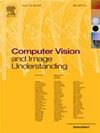Monocular per-object distance estimation with Masked Object Modeling
IF 3.5
3区 计算机科学
Q2 COMPUTER SCIENCE, ARTIFICIAL INTELLIGENCE
引用次数: 0
Abstract
Per-object distance estimation is critical in surveillance and autonomous driving, where safety is crucial. While existing methods rely on geometric or deep supervised features, only a few attempts have been made to leverage self-supervised learning. In this respect, our paper draws inspiration from Masked Image Modeling (MiM) and extends it to multi-object tasks. While MiM focuses on extracting global image-level representations, it struggles with individual objects within the image. This is detrimental for distance estimation, as objects far away correspond to negligible portions of the image. Conversely, our strategy, termed Masked Object Modeling (MoM), enables a novel application of masking techniques. In a few words, we devise an auxiliary objective that reconstructs the portions of the image pertaining to the objects detected in the scene. The training phase is performed in a single unified stage, simultaneously optimizing the masking objective and the downstream loss (i.e., distance estimation).
We evaluate the effectiveness of MoM on a novel reference architecture (DistFormer) on the standard KITTI, NuScenes, and MOTSynth datasets. Our evaluation reveals that our framework surpasses the SoTA and highlights its robust regularization properties. The MoM strategy enhances both zero-shot and few-shot capabilities, from synthetic to real domain. Finally, it furthers the robustness of the model in the presence of occluded or poorly detected objects.

用蒙面对象建模估计单目单目标距离
在安全至关重要的监视和自动驾驶中,每个物体的距离估计至关重要。虽然现有的方法依赖于几何或深度监督特征,但只有少数尝试利用自监督学习。在这方面,本文从蒙面图像建模(MiM)中汲取灵感,并将其扩展到多目标任务中。虽然MiM专注于提取全局图像级表示,但它努力处理图像中的单个对象。这对距离估计是有害的,因为远处的物体对应于图像的可忽略部分。相反,我们的策略,称为屏蔽对象建模(MoM),使屏蔽技术的新应用成为可能。简而言之,我们设计了一个辅助目标,用于重建图像中与场景中检测到的物体相关的部分。训练阶段在一个统一的阶段进行,同时优化掩蔽目标和下游损失(即距离估计)。我们在标准KITTI、NuScenes和MOTSynth数据集上评估了MoM在一种新的参考架构(DistFormer)上的有效性。我们的评估表明,我们的框架超越了SoTA,并突出了它的鲁棒正则化特性。MoM策略增强了从合成域到真实域的零弹和少弹能力。最后,它进一步提高了模型在存在遮挡或检测差的目标时的鲁棒性。
本文章由计算机程序翻译,如有差异,请以英文原文为准。
求助全文
约1分钟内获得全文
求助全文
来源期刊

Computer Vision and Image Understanding
工程技术-工程:电子与电气
CiteScore
7.80
自引率
4.40%
发文量
112
审稿时长
79 days
期刊介绍:
The central focus of this journal is the computer analysis of pictorial information. Computer Vision and Image Understanding publishes papers covering all aspects of image analysis from the low-level, iconic processes of early vision to the high-level, symbolic processes of recognition and interpretation. A wide range of topics in the image understanding area is covered, including papers offering insights that differ from predominant views.
Research Areas Include:
• Theory
• Early vision
• Data structures and representations
• Shape
• Range
• Motion
• Matching and recognition
• Architecture and languages
• Vision systems
 求助内容:
求助内容: 应助结果提醒方式:
应助结果提醒方式:


